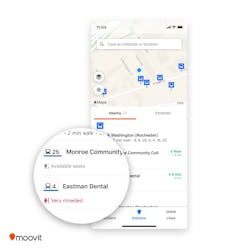Moovit releases real-time crowding, wheelchair accessible feature for its app
Maintaining social distance can help transit riders feel safe and Moovit is incorporating real-time crowding information into its app, which is used by more than 65 transit agencies across the United States, Canada, Australia, Italy and Singapore. The app now displays Available Seats, Standing Room Only or Crowded in the Itinerary, Live Directions, Stations, Line Details and Favorite Lines screens.
“Real-time crowding information eliminates another layer of uncertainty from public transit, especially important during the COVID-19 pandemic,” said Moovit Chief Growth and Marketing Officer Yovav Meydad.
Akron Metro Regional Transit Authority (RTA) in Ohio says the new feature will help its riders make “educated decisions and feel safety riding mass transportation.”
“As we continue navigating this pandemic, real-time crowding information is another valuable tool we can provide to help our passengers feel safe and comfortable while riding,” said Akron Metro RTA CEO Dawn Distler. “For those with carts or strollers, this will also provide peace of mind knowing when there’s extra space onboard for a comfortable trip and help them make travel decisions that work best for them.”
In addition to real-time crowding information, Moovit’s app will also share wheelchair accessible buses, which Moovit says will be in addition to the wheelchair-accessible routes and stations that the app already identifies. The symbol to be displayed indicating wheelchair accessibility has been redesigned by Moovit “to show a more dynamic and engaged person with disability in motion.”
Moovit notes the app is enhanced with screen reading features for low vision users, including TalkBack/VoiceOver capabilities and is designed with optimized menus and buttons for people with hand-motor disabilities.
“Having one app that shows wheelchair accessible lines, routes and stations can be life changing for wheelchair users,” said Meydad. “A vehicle that is not accessible could make getting around impossible, but a single app that makes journey planning more streamlined and simple can open up new opportunities for them.”
About the Author

Mischa Wanek-Libman
Group Editorial Director
Mischa Wanek-Libman is director of communications with Transdev North America. She has more than 20 years of experience working in the transportation industry covering construction projects, engineering challenges, transit and rail operations and best practices.
Wanek-Libman has held top editorial positions at freight rail and public transportation business-to-business publications including as editor-in-chief and editorial director of Mass Transit from 2018-2024. She has been recognized for editorial excellence through her individual work, as well as for collaborative content.
She is an active member of the American Public Transportation Association's Marketing and Communications Committee and served 14 years as a Board Observer on the National Railroad Construction and Maintenance Association (NRC) Board of Directors.
She is a graduate of Drake University in Des Moines, Iowa, where she earned a Bachelor of Arts degree in Journalism and Mass Communication.
